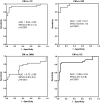Depleted circulatory complement-lysis inhibitor (CLI) in childhood cerebral malaria returns to normal with convalescence
- PMID: 32336276
- PMCID: PMC7184698
- DOI: 10.1186/s12936-020-03241-5
Depleted circulatory complement-lysis inhibitor (CLI) in childhood cerebral malaria returns to normal with convalescence
Abstract
Background: Cerebral malaria (CM), is a life-threatening childhood malaria syndrome with high mortality. CM is associated with impaired consciousness and neurological damage. It is not fully understood, as yet, why some children develop CM. Presented here is an observation from longitudinal studies on CM in a paediatric cohort of children from a large, densely-populated and malaria holoendemic, sub-Saharan, West African metropolis.
Methods: Plasma samples were collected from a cohort of children with CM, severe malarial anaemia (SMA), uncomplicated malaria (UM), non-malaria positive healthy community controls (CC), and coma and anemic patients without malaria, as disease controls (DC). Proteomic two-dimensional difference gel electrophoresis (2D-DIGE) and mass spectrometry were used in a discovery cohort to identify plasma proteins that might be discriminatory among these clinical groups. The circulatory levels of identified proteins of interest were quantified by ELISA in a prospective validation cohort.
Results: The proteome analysis revealed differential abundance of circulatory complement-lysis inhibitor (CLI), also known as Clusterin (CLU). CLI circulatory level was low at hospital admission in all children presenting with CM and recovered to normal level during convalescence (p < 0.0001). At acute onset, circulatory level of CLI in the CM group significantly discriminates CM from the UM, SMA, DC and CC groups.
Conclusions: The CLI circulatory level is low in all patients in the CM group at admission, but recovers through convalescence. The level of CLI at acute onset may be a specific discriminatory marker of CM. This work suggests that CLI may play a role in the pathophysiology of CM and may be useful in the diagnosis and follow-up of children presenting with CM.
Keywords: Biomarkers; Cerebral malaria; Childhood severe malaria; Pathogenesis.
Conflict of interest statement
The authors declare that they have no competing interests.
Figures



Similar articles
-
Combined measurement of soluble and cellular ICAM-1 among children with Plasmodium falciparum malaria in Uganda.Malar J. 2010 Aug 16;9:233. doi: 10.1186/1475-2875-9-233. Malar J. 2010. PMID: 20712868 Free PMC article.
-
Chitinase 3-like 1 is induced by Plasmodium falciparum malaria and predicts outcome of cerebral malaria and severe malarial anaemia in a case-control study of African children.Malar J. 2014 Jul 21;13:279. doi: 10.1186/1475-2875-13-279. Malar J. 2014. PMID: 25047113 Free PMC article.
-
Circulatory hepcidin is associated with the anti-inflammatory response but not with iron or anemic status in childhood malaria.Blood. 2013 Apr 11;121(15):3016-22. doi: 10.1182/blood-2012-10-461418. Epub 2013 Feb 4. Blood. 2013. PMID: 23380741 Free PMC article.
-
Folic acid supplementation and malaria susceptibility and severity among people taking antifolate antimalarial drugs in endemic areas.Cochrane Database Syst Rev. 2022 Feb 1;2(2022):CD014217. doi: 10.1002/14651858.CD014217. Cochrane Database Syst Rev. 2022. PMID: 36321557 Free PMC article.
-
Neurological Complications of Malaria.Curr Neurol Neurosci Rep. 2022 Aug;22(8):499-513. doi: 10.1007/s11910-022-01214-6. Epub 2022 Jun 14. Curr Neurol Neurosci Rep. 2022. PMID: 35699901 Free PMC article. Review.
References
-
- WHO. World malaria report 2018. Geneva: World Health Organization; 2018. https://apps.who.int/iris/bitstream/handle/10665/275867/9789241565653-en....
MeSH terms
Substances
Grants and funding
LinkOut - more resources
Full Text Sources
Research Materials
Miscellaneous

